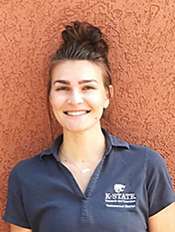
Generally, it is recommended to plant hardy bulbs (especially daffodils) in October to give them enough time to root before winter. But it is certainly not too late to plant them in early November. If the soil temperatures are above 40 degrees F, the bulbs should continue root development.
You can find the previous week’s soil temperature readings for areas across the state from our Weather Data Library at http://mesonet.k-state.edu/agriculture/soiltemp/Although many of the best bulbs have probably already been purchased, garden centers may still have a good selection. Be sure to select large, firm bulbs that have not begun to sprout. While many bulbs can adapt to a wide range of soil types, none can tolerate poorly drained soil. Prepare the planting bed by adding organic matter such as peat moss, well-rotted manure, or compost and mix it into the soil.Adequate fertility is essential. It is best to rely on a soil test to determine what nutrients are needed. Garden soils that have been fertilized regularly in the past may have excess levels of phosphorus. Excess phosphorus can interfere with the uptake of other essential micronutrients though levels need to be extremely high to be of concern. In cases where levels of phosphorus are high, it would be better to use a fertilizer relatively high in nitrogen such as a 29-5-4, 27-3-3, or something similar. Although these are lawn fertilizers, they will work well for our purposes if they don’t contain and weed preventer or weed killer. Apply these fertilizers at the rate of 2/3 pounds (3 cups) per 100 square feet.
Organic sources of fertilizers low in phosphorus include blood meal (12-0-0) applied at 2 pounds per 100 square feet (1 tsp per sq ft), cottonseed meal (6-0.4-1.5) applied at the rate of 3 pounds per 100 square feet (2 tsp /per sq ft) and soybean meal (7-2-1) applied at the rate of 3 pounds per 100 square feet (2 tsp /per sq ft).
In the absence of a soil test, or if phosphorus is needed, add a low analysis, balanced fertilizer such as 5-10-5 or 6-10-4 at the rate of 3 pounds (6 cups) per 100 square feet of bed or 2 tsp/per sq ft. Mix all amendments thoroughly with the soil before planting the bulbs.
The size and species of the bulb determine how deep to plant. In general, the depth to the bottom of the bulb should be about 2 to 3 times the size of the bulb but check the planting instructions specific to each flower.
Lauren Walz is the Horticulture Extension Agent for the Cottonwood Extension District. If you have questions, she can be contacted by e-mail at [email protected] or by phone at 785-628-9430 or 620-793-1910.






